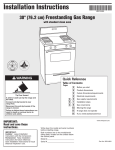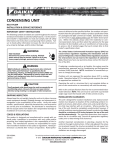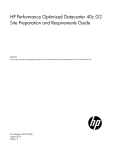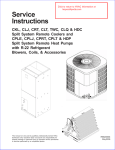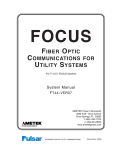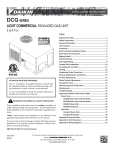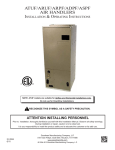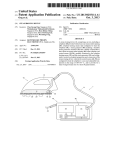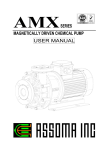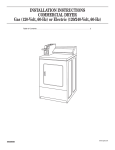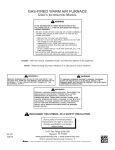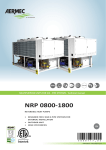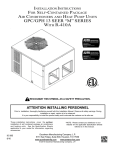Download Goodman ARUF Installation Manual
Transcript
ARUF**14** / ASPT**14** AIR HANDLERS INSTALLATION & OPERATING INSTRUCTIONS Contents 1 2 3 4 5 6 7 8 9 10 11 12 13 14 15 16 21 Important Safety Instructions ................................... 1 Shipping Inspection ............................................... 3 2.1 Parts .......................................................... 3 2.2 Handling ...................................................... 3 Codes & Regulations .............................................. 3 Replacement Parts ................................................ 3 Pre-Installation Considerations ................................ 3 5.1 Preparation .................................................. 3 5.2 System Matches ............................................. 3 5.3 Interconnecting Tubing ..................................... 3 5.4 Clearances ................................................... 4 5.5 Horizontal Applications .................................... 4 Installation Location ............................................. 4 6.1 Upflow Installation ......................................... 4 6.2 Horizontal Left Installation ............................... 4 6.3 Downflow ..................................................... 4 6.4 Horizontal Right Installation .............................. 5 Refrigerant Lines .................................................. 7 7.1 Tubing Size ................................................... 7 7.2 Tubing Preparation ......................................... 7 7.3 Special Instructions ......................................... 7 7.4 Tubing Connections for Flowrator Model ............... 7 7.5 Tubing Connections for TXV Models ...................... 8 Condensate Drain Lines .......................................... 8 Ductwork ............................................................ 9 9.1 Return Ductwork ............................................ 9 Return Air Filters ................................................ 9 Electric Heat ...................................................... 9 Electrical and Control Wiring ............................... 11 12.1 Building Electrical Service Inspection ................ 11 12.2 Wire Sizing ............................................... 11 12.3 Maximum Overcurrent Protection (MOP) ............ 11 12.4 Electrical Connections – Supply Voltage ............. 12 12.4.1 Air Handler Only (Non-Heat Kit Models) ..... 12 12.4.2 Air Handler - Non-Circuit Breaker Heat Kits ...... 12 12.4.3 Air Handler With Circuit Breaker Heat Kit ........ 12 12.5 Low Voltage Connections ............................... 12 12.5.1 Thermostats .......................................... 12 12.6 Speed Tap Adjustment .................................. 12 Achieving 1.4% Low Leakage Rate ......................... 13 Start-Up Procedure ............................................ 13 Regular Maintenance .......................................... 13 Airflow Data .................................................... 14 Wiring Diagrams ................................................ 20 RECOGNIZE THIS SYMBOL AS A SAFETY PRECAUTION. 1 Important Safety Instructions The following symbols and labels are used throughout this manual to indicate immediate or potential safety hazards. It is the owner’s and installer’s responsibility to read and comply with all safety information and instructions accompanying these symbols. Failure to heed safety information increases the risk of personal injury, property damage, and/ or product damage. Keep this literature in a safe place for future reference. ATTENTION INSTALLING PERSONNEL IO-901 2/2015 Prior to installation, thoroughly familiarize yourself with this Installation Manual. Observe all safety warnings. During installation or repair, caution is to be observed. It is your responsibility to install the product safely and to educate the customer on its safe use. HIGH VOLTAGE! Disconnect ALL power before servicing. Multiple power sources may be present. Failure to do so may cause property damage, personal injury or death. Installation and repair of this unit should be performed ONLY by individuals meeting the requirements of an “entry level technician”, at a minimum, as specified by the Air-Conditioning, Heating and Refrigeration Institute (AHRI). Attempting to install or repair this unit without such background may result in product damage, personal injury or death. This product is factory-shipped for use with 208/240/1/60 electrical power supply. DO NOT reconfigure this air handler to operate with any other power supply. CO can cause serious illness including permanent brain damage or death. To avoid property damage, personal injury or death due to electrical shock, this unit MUST have an uninterrupted, unbroken electrical ground. The electrical ground circuit may consist of an appropriately sized electrical wire connecting the ground lug in the unit control box to the building electrical service panel. Other methods of grounding are permitted if performed in accordance with the National Electric Code (NEC)/American National Standards Institute (ANSI)/National Fire Protection Association (NFPA) 70 and local/state codes. In Canada, electrical grounding is to be in accordance with the Canadian Electric Code (CSA) C22.1. Advertencia especial para la instalación de calentadores ó manejadoras de aire en áreas cerradas como estacionamientos ó cuartos de servicio. Las emisiones de monóxido de carbono pueden circular a través del aparato cuando se opera en cualquier modo. El monóxido de carbono puede causar enfermedades severas como daño cerebral permanente ó muerte. When installing or servicing this equipment, safety clothing, including hand and eye protection, is strongly recommended. If installing in an area that has special safety requirements (hard hats, etc.), observe these requirements. RISQUE D'EMPOISONNEMENT AU MONOXYDE DE CARBONE Do not connect to or use any device that is not designcertified by the manufacturer for use with this unit. Serious property damage, personal injury, reduced unit performance and/or hazardous conditions may result from the use of such non-approved devices. Cette ventilation est nécessaire pour éviter le danger d'intoxication au CO pouvant survenir si un appareil produisant du monoxyde de carbone continue de fonctionner au sein de la zone confinée. To prevent the risk of property damage, personal injury, or death, do not store combustible materials or use gasoline or other flammable liquids or vapors in the vicinity of this unit. 2 2 Shipping Inspection Always transport the unit upright; laying the unit on its side or top during transit may cause equipment damage. The installer should inspect the product upon receipt for shipping damage and subsequent investigation is the responsibility of the carrier. The installer must verify the model number, specifications, electrical characteristics, and accessories are correct prior to installation. The distributor or manufacturer will not accept claims from dealers for transportation damage or installation of incorrectly shipped units. 2.1 Parts Also inspect the unit to verify all required components are present and intact. Report any missing components immediately to the manufacturer or to the distributor. Use only factory authorized replacement parts (see Section 5). Make sure to include the full product model number and serial number when reporting and/or obtaining service parts. 2.2 Handling Use caution when transporting/carrying the unit. Do not move unit using shipping straps. Do not carry unit with hooks or sharp objects. The preferred method of carrying the unit after arrival at the job site is to carry via a two-wheel hand truck from the back or sides or via hand by carrying at the cabinet corners. 3 Codes & Regulations This product is designed and manufactured to comply with applicable national codes. Installation in accordance with such codes and/or prevailing local codes/regulations is the responsibility of the installer. The manufacturer assumes no responsibility for equipment installed in violation of any codes or regulations. The United States Environmental Protection Agency (EPA) has issued various regulations regarding the introduction and disposal of refrigerants. Failure to follow these regulations may harm the environment and can lead to the imposition of substantial fines. Should you have any questions please contact the local office of the EPA and/or refer to EPA’s website www.epa.gov. 4 Replacement Parts When reporting shortages or damages, or ordering repair parts, give the complete product model and serial numbers as stamped on the product. Replacement parts for this product are available through your contractor or local distributor. For the location of your nearest distributor consult the white business pages, the yellow page section of the local telephone book or contact: CONSUMER AFFAIRS GOODMAN MANUFACTURING COMPANY, L.P. 7401 SECURITY WAY HOUSTON, TEXAS 77040 (877) 254-4729 5 Pre-Installation Considerations 5.1 Preparation Keep this document with the unit. Carefully read all instructions for the installation prior to installing product. Make sure each step or procedure is understood and any special considerations are taken into account before starting installation. Assemble all tools, hardware and supplies needed to complete the installation. Some items may need to be purchased locally. Make sure everything needed to install the product is on hand before starting. 5.2 System Matches The entire system (combination of indoor and outdoor sections) must be manufacturer approved and Air-Conditioning, Heating, and Refrigeration Institute (AHRI) listed. NOTE: Installation of unmatched systems is not permitted and will void the product warranty. 5.3 Interconnecting Tubing Give special consideration to minimize the length of refrigerant tubing when installing air handlers. Refer to Remote Cooling/Heat Pump Service Manual RS6200006, and TP-107 Long Line Set Application R-410A for tubing guidelines. If possible, allow adequate length of tubing such that the coil may be removed (for inspection or cleaning services) from the cabinet without disconnecting the tubing. 3 5.4 Clearances The unit clearance from a combustible surface may be 0". However, service clearance must take precedence. A minimum of 24" in front of the unit for service clearance is required. Additional clearance on one side or top will be required for electrical wiring connections. Consult all appropriate regulatory codes prior to determining final clearances. When installing this unit in an area that may become wet (such as crawl spaces), elevate the unit with a sturdy, non-porous material. In installations that may lead to physical damage (i.e. a garage) it is advised to install a protective barrier to prevent such damage. Always install units such that a positive slope in condensate line (1/4" per foot) is allowed. 5.5 Horizontal Applications If installed above a finished living space, a secondary drain pan (as required by many building codes), must be installed under the entire unit and its condensate drain line must be routed to a location such that the user will see the condensate discharge. 6 Installation Location NOTE: These air handlers are designed for indoor installation only. The ARUF**14** and ASPT**14** product lines may be installed in one of the upflow, downflow, horizontal left or horizontal right orientations as shown in Figures 2, 3, 4 and 5. The unit may be installed in upflow or horizontal left orientation as shipped (refer to specific sections for more information). Minor field modifications are necessary to convert to downflow or horizontal right as indicated in below sections. Side Drain Pan Removal: Refer to Figure 1, remove the two (2) screws that secure the drip shield support brackets to the condensate collectors (front and back). Unsnap the side drain pan from vertical (bottom) drain pan using a screw driver or any small lever. The side drain pan and drip shield brackets may now be removed. The bottom left drain connection is the primary drain for this application and condensate drain line must be attached to this drain connection. The bottom right drain connection is for the secondary drain line (if used). 6.1 Upflow Installation No field modifications are mandatory however to obtain maximum efficiency, the horizontal side drain pan & extension must be removed. DRIP SHIELD REMOVAL Figure 1 6.2 Horizontal Left Installation No field modifications are permissible for this application. The bottom left drain connection is the primary drain for this application and condensate drain line must be attached to this drain connection. The bottom right drain connection is for the secondary drain line (if used). MODEL LIST FOR DOWNFLOW KIT 6.3 Downflow DFK-B DFK-C DFK-D No field modifications are mandatory however to obtain DOWNFLOW KIT DOWNFLOW KIT DOWNFLOW KIT maximum efficiency, the horizontal side drainpan & extenARUF25B14** ARUF37C14** ARUF37D14** sion must be removed. ARUF29B14** ARUF43C14** ARUF43D14** IMPORTANT NOTE: To prevent coil pan “sweating” in the ARUF31B14** ARUF49C14** ARUF47D14** downflow application, a downflow kit (DFK) is available through your local distributor. The DFK is not supplied with ARUF49D14** the air handler and is required by the manufacturer on all ARUF61D14** downflow installations. See Table 1 for the correct DFK and ASPT61D14** follow the instructions provided for installation. DOWNFLOW KIT Table 1 4 6.4 Horizontal Right Installation Side drainpan extension must be removed for all models except : ARUF47D14**, ARUF61D14**, ASPT61D14**. Refer to Figure 6 and 7 for the location of the components referenced in the following steps. 1. Before inverting the air handler, remove blower access panel and coil access panel. The coil access panel and tubing panel may remain screwed together during this procedure. Remove and retain the seven (7) screws securing the coil access panel to the cabinet and the six (6) screws securing the blower access panel to the cabinet. 2. Slide the coil assembly out from the cabinet. Use the drain pan to pull the assembly from the cabinet. NOTE: DO NOT USE MANIFOLDS OR FLOWRATOR TO PULL THE COIL ASSEMBLY OUT. FAILURE TO DO SO MAY RESULT IN BRAZE JOINT DAMAGE AND LEAKS. 3. Removal of the center support is required on units with 21" wide cabinet. Remove and retain the two (2) screws that secure the center support to the cabinet. Remove the center support. 4. Using the drain pan to hold the coil assembly, slide the coil assembly back into the cabinet on the downflow brackets as shown in Figure 8. 5. Re-install the center support (if removed) using the two (2) screws removed in Step 4. 6. Re-install the access panels removed in Step 1 as shown in Figure 9. 7. The bottom right drain connection is the primary drain for this application and condensate drain line must be attached to this drain connection. The bottom left drain connection is for the secondary drain line (if used). Install the PVC plug that was removed from the side drain pan primary connection and install it on the vertical primary connection. NOTE: If removing only the coil access panel from the unit, the filter access panel must be removed first. Failure to do so will result in panel damage. UPFLOW DOWNFLOW Figure 2 Figure 3 HORIZONTAL LEFT HORIZONTAL RIGHT Figure 4 Figure 5 5 Blower Access Panel Secondary Drain Port for Horizontal Application Tubing Panel Secondary Drain Port for Upflow/Downflow Application INTERNAL PART TERMINOLOGY EXTERNAL PART TERMINOLOGY Figure 6 Figure 7 Coil Slides on the downflow bracket IMPORTANT NOTE: Ensure coil slides on the rails along the groove provided on the drain pan side walls. Failure to do so will result in improper condensate drainage. COIL INSTALLATION FOR DOWNFLOW Figure 8 6 ACCESS PANEL CONFIGURATION FOR DOWNFLOW OR HORIZONTAL RIGHT Figure 9 7 Refrigerant Lines NOTE: Refrigerant tubing must be routed to allow adequate access for servicing and maintenance of the unit. Do not install the air handler in a location that violates the instructions provided with the condenser. If the unit is located in an unconditioned area with high ambient temperature and/or high humidity, the air handler may be subject to nuisance sweating of the casing. On these installations, a wrap of 2" fiberglass insulation with a vapor barrier is recommended. This product is factory-shipped with R410A and dry nitrogen mixture gas under pressure. Use appropriate service tools and follow these instructions to prevent injury. A quenching cloth is strongly recommended to prevent scorching or marring of the equipment finish when brazing close to the painted surfaces. Use brazing alloy of 5% minimum silver content. 7.1 Tubing Size For the correct tubing size, follow the specification for the condenser/heat pump. CAUTION Applying too much heat to any tube can melt the tube. Torch heat required to braze tubes of various sizes must be proportional to the size of the tube. Service personnel must use the appropriate heat level for the size of the tube being brazed. 7.2 Tubing Preparation All cut ends are to be round, burr free, and clean. Failure to follow this practice increases the chances for refrigerant leaks. The suction line is spun closed and requires tubing cutters to remove the closed end. NOTE: To prevent possible damage to the tubing joints, do not handle coil assembly with manifold or flowrator tubes. Always use clean gloves when handling coil assemblies. 7.3 Special Instructions Units without a factory installed TXV come equipped with a flowrator piston for refrigerant expansion. For most installations with matching applications, no change to the flowrator piston is required. However, in mix-matched applications, a flowrator piston change may be required. See the piston kit chart (provided in the literature packet) or consult your local distributor for details regarding mix-matched flowrator piston sizing. If the mix-match application requires a different flowrator piston size, change the flowrator piston in the flowrator body on the indoor coil before installing the coil and use the procedure in section 8.4. NOTE: The use of a heat shield is strongly recommended when brazing to avoid burning the serial plate or the finish of the unit. Heat trap or wet rags must be used to protect heat sensitive components such as service valves and TXV valves sensing bulb. 7.4 Tubing Connections for Flowrator Model 1. Loosen the 13/16 nut 1 TURN ONLY to allow high pressure tracer gas to escape. No gas indicates a possible leak. SUCTION LINE WITH SPIN CLOSURE 2. After the gas has been expelled, remove the nut and discard the black or brass cap plastic seal. 3. Remove the flowrator piston to verify it is the correct size for the outdoor unit being installed and then replace the piston (changing size, if needed). See piston kit chart in the literature kit for appropriate piston size. 4. Remove the spin closure on the suction line using a tube cutter and deburr the tube. RUBBER GROMMET SUCTION SPUN END AND GROMMET Figure 10 5. Insert the suction line into the connection, slide the insulation and the rubber grommet at least 18" away from the braze joint. 6. Remove the tailpiece clamped to the exterior of the cabinet or in the literature kit packet and slide the 13/16 nut into place. 7. Braze tailpiece to the line set liquid tube and braze suction line connection. Quench all brazed joints with a damp rag upon completion of brazing. Do not allow water to enter the inside of the tubing. 7 8. AFTER THE TAILPIECE HAS COOLED, confirm position of the white Teflon® seal and hand tighten the 13/16 nut. 9. Torque the 13/16 nut to 7-25 ft-lbs. or tighten 1/6 turn. PLASTIC or BRASS CAP 13/16” NUT TAILPIECE Excessive torque can cause orifices to stick. Use the proper torque settings when tightening orifices. PISTON WHITE TEFLON SEAL TAILPIECE JOINT 7.5 Tubing Connections for TXV Models Figure 11 TXV models come with factory installed TXV with the bulb preinstalled on the vapor tube. 1. Remove refrigerant tubing panel or coil (lower) access panel. 2. Remove access valve fitting cap and depress the valve stem in access fitting to release pressure. No pressure indicates possible leak. 3. Replace the refrigerant tubing panel. 4. Remove the spin closure on both the liquid and suction tubes using a tubing cutter. 5. Insert liquid line set into liquid tube expansion and slide grommet about 18" away from braze joint. 6. Insert suction line set into suction tube expansion and slide insulation and grommet about 18" away from braze joint. 7. Braze joints. Quench all brazed joints with water or a wet rag upon completion of brazing. 8 Condensate Drain Lines The coil drain pan has a primary and a secondary drain with 3/4" NPT female connections. The connectors required are 3/ 4" NPT male, either PVC or metal pipe, and should be hand tightened to a torque of no more than 37 in-lbs. to prevent damage to the drain pan connection. An insertion depth of approximately 3/8” to 1/2” (3-5 turns) should be expected at this torque. 1. Ensure drain pan hole is not obstructed. 2. To prevent potential sweating and dripping on to finished space, it may be necessary to insulate the condensate drain line located inside the building. Use Armaflex® or similar material. A secondary condensate drain connection has been provided for areas where the building codes require it. Pitch all drain lines a minimum of 1/4" per foot to provide free drainage. Provide required support to the drain line to prevent bowing. If the secondary drain line is required, run the line separately from the primary drain and end it where condensate discharge CAUTION can be easily seen. NOTE: Water coming from secondary line means the coil priIf secondary drain is not installed, the secondary mary drain is plugged and needs immediate attention. access must be plugged. Insulate drain lines located inside the building or above a finished living space to prevent sweating. Install a condensate trap to ensure proper drainage. NOTE: When units are installed above ceilings, or in other locations where damage from condensate overflow may occur, it is MANDATORY to install a field fabricated auxiliary drain pan under the coil cabinet enclosure. The installation must include a “P” style trap that is located as close as is practical to the evaporator coil. See Figure 12 for details of a typical condensate line “P” trap. NOTE: Trapped lines are required by many local codes. In the absence of any prevailing local codes, please refer to the requirements listed in the Uniform Mechanical Building Code. 8 Drain Connection Air Handler 2" MIN. POSITIVE LIQUID SEAL REQUIRED AT TRAP 3" MIN. Figure 12 A drain trap in a draw-through application prevents air from being drawn back through the drain line during fan operation thus preventing condensate from draining, and if connected to a sewer line to prevent sewer gases from being drawn into the airstream during blower operation. Field experience has shown condensate drain traps with an open vertical Tee between the air handler and the condensate drain trap can improve condensate drainage in some applications, but may cause excessive air discharge out of the open Tee. The manufacturer does not prohibit this type of drain but we also do not recommend it due to the resulting air leakage. Regardless of the condensate drain design used, it is the installer’s responsibility to ensure the condensate drain system is of sufficient design to ensure proper condensate removal from the coil drain pan. Use of a condensate removal pump is permitted when necessary. This condensate pump should have provisions for shutting off the control voltage should a blocked drain occur. A trap must be installed between the unit and the condensate pump. IMPORTANT NOTE: The evaporator coil is fabricated with oils that may dissolve styrofoam and certain types of plastics. Therefore, a removal pump or float switch must not contain any of these materials. Tip: Priming the “P” trap may avoid improper draining at the initial installation and at the beginning of the cooling season. 9 Ductwork This air handler is designed for a complete supply and return ductwork system. Do not operate this product without all the ductwork attached. To ensure correct system performance, the ductwork is to be sized to accommodate 350-450 CFM per ton of cooling with the static pressure not to exceed 0.5" in w.c. Refer to ACCA Manual D, Manual S and Manual RS for information on duct sizing and application. Flame retardant ductwork is to be used and sealed to the unit in a manner that will prevent leakage. NOTE: A downflow application with electric heat must have an L-shaped sheet metal supply duct without any outlets or registers located directly below the heater. 9.1 Return Ductwork DO NOT LOCATE THE RETURN DUCTWORK IN AN AREA THAT CAN INTRODUCE TOXIC, OR OBJECTIONABLE FUMES/ ODORS INTO THE DUCTWORK. The return ductwork is to be connected to the air handler bottom (upflow configuration). 10 Return Air Filters Each installation must include a return air filter. This filtering may be performed at the air handler using the factory filter rails or externally such as a return air filter grille. When using the factory filter rails, a nominal 16x20x1”, 20x20x1” or 24x20x1” (actual dimension must be less than 23-½”x20”) filter can be installed on a B, C and D cabinet respectively (the cabinet size is the seventh letter of the model number). 11 Electric Heat Refer to the installation manual provided with the electric heat kit for the correct installation procedure. All electric heat must be field installed. If installing this option, the ONLY heat kits that are permitted to be used are the HKS series. Refer to the air handler unit’s Serial and Rating plate or the HKS specification sheets to determine the heat kits compatible with a given air handler. No other accessory heat kit besides the HKS series may be installed in these air handlers. The heating mode temperature rise is dependent upon the system airflow, the supply voltage, and the heat kit size (kW) selected. Use data provided in Tables 2, 3 and 4 to determine the temperature rise (°F). NOTE: For installations not indicated above the following formula is to be used: Where: TR kW 3412 VC* = = = = = = 1.08 = CFM = TR = (kW x 3412) x (Voltage Correction) / (1.08XCFM) Temperature Rise Heater Kit Actual kW Btu per kW .96 (230 Supply Volts) .92 (220 Supply Volts) .87 (208 Supply Volts) Constant Measured Airflow *VC (Voltage Correction) 9 NOTE: The Temperature Rise Tables can also be used to estimate the air handler airflow delivery. When using these tables for this purpose set the room thermostat to maximum heat and allow the system to reach steady state conditions. Insert two thermometers, one in the return air and one in the supply air. The temperature rise is the supply air temperature minus the room air temperature. Using the temperature rise calculated, CFM can be estimated from the TR formula above. See Technical Manual and/or Service Manual for more information. HEAT KIT NOMINAL kW CFM HEAT KIT NOMINAL kW CFM 3 5 6 8 10 800 11 18 22 30 35 1000 9 14 18 24 28 42 62 1200 7 12 15 20 24 35 47 59 42 53 1400 6 10 13 17 20 30 40 51 28 37 46 1600 6 9 11 15 18 27 35 44 16 25 33 41 1800 5 8 10 13 16 24 31 39 15 22 30 37 2000 4 7 9 12 14 21 28 35 3 5 6 8 10 15 19/20 25 800 12 19 23 31 37 1000 9 15 19 25 30 44 1200 8 12 15 21 25 37 49 1400 7 11 13 18 21 32 1600 6 9 12 15 19 1800 5 8 10 14 2000 5 7 9 12 230/1/60 SUPPLY VOLTAGE - TEMP. RISE °F Table 2 CFM 15 19/20 25 220/1/60 SUPPLY VOLTAGE - TEMP. RISE °F Table 3 HEAT KIT NOMINAL kW 3 5 6 8 10 15 19/20 25 800 10 17 21 28 33 1000 8 13 17 22 27 40 1200 7 11 14 19 22 33 45 56 1400 6 10 12 16 19 29 38 48 1600 5 8 10 14 17 25 33 42 1800 5 7 9 12 15 22 30 37 2000 4 7 8 11 13 20 27 33 208/1/60 SUPPLY VOLTAGE - TEMP. RISE °F Table 4 M ODEL HEATER KIT (KW) 3 5 6 8 10 ARUF25B14 715 715 715 715 950 ARUF29B14 715 715 715 715 950 ARUF31B14 715 15 19 20 25 715 715 715 875 875 ARUF37C14 1170 1170 1170 1170 1345 1345 ARUF43C14 1170 1170 1170 1170 1345 1345 ARUF49C14 1170 1170 1170 1170 1340 1430 ARUF37D14 1170 1170 1170 1170 1345 1345 ARUF43D14 1170 1170 1170 1170 1345 1345 ARUF47D14 1170 1170 1170 1170 1345 1345 ARUF49D14 1240 1240 1240 1240 1520 1520 ARUF61D14 1590 1590 1590 1590 1715 1715 1715 ASPT61D14 1590 1590 1590 1590 1715 1715 1715 MINIMUM CFM REQUIRED FOR HEATER KITS Table 5 10 12 Electrical and Control Wiring Nominal Input Minimum Voltage Maximum Voltage 208-240 197 253 IMPORTANT: All routing of electrical wiring must be made through provided electrical knockouts. Do not cut, puncture or alter the cabinet for electrical wiring. ELECTRICAL VOLTAGE Table 6 12.1 Building Electrical Service Inspection This unit is designed for single-phase electrical supply only. DO NOT OPERATE ON A THREE-PHASE POWER SUPPLY. Measure the power supply to the unit. The supply voltage must be measured and be in agreement with the unit nameplate power requirements and within the range shown. 12.2 Wire Sizing Wire size is important to the operation of your equipment. Use the following check list when selecting the appropriate wire size for your unit. • Wire used must carry the Minimum Circuit Ampacity (MCA) listed on the unit’s Series and Rating Plate. • Refer to the NEC (USA) or CSA (Canada) for wire sizing. The unit MCA for the air handler and the optional electric heat kit can be found on the unit Series and Rating Plate. • Wire must be sized to allow no more than a 2% voltage drop from the building breaker/fuse panel to the unit. • Wires with different insulation temperature rating have varying ampacities - be sure to check the temperature rating used. Refer to the latest edition of the National Electric Code or in Canada the Canadian Electric Code when determining the correct wire size. 12.3 Maximum Overcurrent Protection (MOP) Every installation must include an NEC (USA) or CEC (Canada) approved overcurrent protection device. Also, check with local or state codes for any special regional requirements. Protection can be in the form of fusing or HACR style circuit breakers. The Series and Rating Plate provides the maximum overcurrent device permissible. FIRE HAZARD! To avoid the risk of property damage, personal injury or fire, use only copper conductors. HIGH VOLTAGE! Disconnect ALL power before servicing. Multiple power sources may be present. Failure to do so may cause property damage, personal injury or death. HIGH VOLTAGE! To avoid property damage, personal injury or death due to electrical shock, this unit MUST have an uninterrupted, unbroken electrical ground. The electrical ground circuit may consist of an appropriately sized electrical wire connecting the ground lug in the unit control box to the building electrical service panel. Other methods of grounding are permitted if performed in accordance with the National Electric Code (NEC)/American National Standards Institute (ANSI)/National Fire Protection Association (NFPA) 70 and local/state codes. In Canada, electrical grounding is to be in accordance with the Canadian Electric Code (CSA) C22.1. NOTE: Fuses or circuit breakers are to be sized larger than the equipment MCA but not to exceed the MOP. 11 12.4 Electrical Connections – Supply Voltage IMPORTANT NOTE: USE COPPER CONDUCTORS ONLY. Knockouts are provided on the air handler top panel and sides of the cabinet to allow for the entry of the supply voltage conductors, as shown in Figure 13. If the knockouts on the cabinet sides are used for electrical conduit, an adapter ring must be used in order to meet UL1995 safety requirements. An NEC or CEC approved strain relief is to be used at this entry point. Some codes/municipalities require the supply wire to be enclosed in conduit. Consult your local codes. Top of Cabinet Side of Cabinet 12.4.1 Air Handler Only (Non-Heat Kit Models) KNOCK-OUT FOR ELECTRICAL CONNECTIONS The building supply connects to the stripped black and red Figure 13 wires contained in the air handler electrical compartment cavity. A ground screw is also contained in this area. Attach the Supply wires to the air handler conductors as shown in the unit wiring diagram using appropriately sized solderless connectors or other NEC or CEC approved means. 12.4.2 Air Handler - Non-Circuit Breaker Heat Kits A terminal block is provided with the HKS kit to attach the power supply and air handler connections. Follow the HKS Installation Manual and wiring diagram for complete wiring details. 12.4.3 Air Handler With Circuit Breaker Heat Kit The air handler has a plastic cover on the upper access panel that will require either one or both sections to be removed to allow the heat kit circuit breaker(s) to be installed. The circuit breakers have lugs for power supply connection. See the HKS Installation Instructions for further details. 12.5 Low Voltage Connections Several combinations of low voltage schemes are possible, depending on the presence of a heat kit and whether the heat kit is single-stage or multi-stage, whether the outdoor section is an air conditioner or heat pump, and whether the outdoor section is single-stage or two-stage. The 24V-control voltage connects the air handler to the room thermostat and condenser. Low voltage wiring must be copper conductors. A minimum of 18AWG must be used for installations up to 100 feet. Low voltage wiring must be connected through the top of the cabinet or either side. See the “Thermostat Wiring” section of this manual for typical low voltage wiring connections. 12.5.1 Thermostats Second-stage heat can be accomplished by a multi-stage heating thermostat or the addition of an outdoor thermostat as shown in wiring schematics on pages 14 and 15. Follow the thermostat manufacturer’s instructions for installation. 12.6 Speed Tap Adjustment ARUF**14** air handlers have multi-speed PSC motors. The color of the wire coming from the motor to the “COM” terminal on the control board defines at which speed the motor will operate. Black wire is high speed, blue wire is medium speed and red wire is low speed. To change speeds, remove the wire attached to the “COM” terminal on the control board, and swap it with the wire (on terminal “M1” or “M2”) with the color that will give the desired speed. ASPT**14** air handlers feature energy efficient blower motors. The motors run at a constant torque with very low power consumption and are energized by 24 VAC. Adjust the CFM by changing the 24 VAC leads to the desired speed tap on the terminal block. The ASPT blower motor speeds are programmed to deliver adequate airflow at rated external static pressure and with 60 second off time delay. For details, refer to the specification sheet applicable to your model. NOTE: In some models, not all speed taps are allowable for certain electric heat applications. Refer to Table 5 for minimum speed. 12 13 Achieving 1.4% Low Leakage Rate Ensure all the gaskets remain intact on all surfaces as shipped with the unit. These surfaces are areas between the upper tie plate and blower access panel, blower access and coil access panels, and between the coil access and filter access panels. Ensure upon installation, that the plastic breaker cover is sitting flush on the blower access panel and all access panels are flush with each other and the cabinet. With these requirements satisfied, the unit achieves less than 1.4% airflow leakage when tested in accordance with ASHRAE Standard 193. 14 Start-Up Procedure • Prior to start-up, ensure that all electrical wires are properly sized and all connections are properly tightened. • All panels must be in place and secured. For Air Tight application, gasket must be positioned at prescribed locations to achieve 1.4% leakage. • Tubing must be leak free. • Condensate line must be trapped and pitched to allow for drainage. • Low voltage wiring is properly connected. • Auxiliary drain is installed when necessary and pitched to allow for drainage. • Unit is protected from vehicular or other physical damage. • Return air is not obtained from, nor are there any return air duct joints that are unsealed in, areas where there may be objectionable odors, flammable vapors or products of combustion such as carbon monoxide (CO), which may cause serious personal injury or death. 15 Regular Maintenance The only item required to be maintained on a regular basis by the user is the circulating air filter(s). Filter should be cleaned or replaced regularly, typically once per month. A certified service technician must perform all other services. IMPORTANT NOTE: If thumb screws are used to access the filter, ensure the washer installed on the screw behind the access panel remains in place after re-installation. 13 HIGH VOLTAGE! Disconnect ALL power before servicing or installing this unit. Multiple power sources may be present. Failure to do so may cause property damage, personal injury or death. 16 Airflow Data Model ARUF25B14 ARUF29B14 ARUF31B14 Static Pressure (in w.c) Airflow (CFM) Blower Speed 0.1 0.2 0.3 0.4 0.5 0.6 0.7 LOW 650 620 595 540 490 420 275 M ED HIGH 885 1255 865 1225 825 1130 815 1090 750 965 690 925 560 800 LOW 650 620 595 540 490 420 275 M ED HIGH 885 1255 865 1225 825 1130 815 1090 750 965 690 925 560 800 LOW 660 625 595 560 500 430 330 M ED HIGH 930 1235 905 1185 865 1130 820 1060 765 990 700 910 590 825 LOW 1120 1085 1040 1000 940 875 800 M ED HIGH 1425 1625 1385 1575 1345 1520 1285 1460 1220 1375 1145 1295 1060 1200 ARUF43C14 LOW M ED HIGH 1120 1425 1625 1085 1385 1575 1040 1345 1520 1000 1285 1460 940 1220 1375 875 1145 1295 800 1060 1200 ARUF49C14 LOW M ED HIGH 1295 1535 1755 1255 1485 1680 1225 1420 1590 1175 1370 1515 1120 1295 1425 1055 1215 1340 970 1130 1250 ARUF37D14 LOW M ED HIGH 1155 1505 1785 1115 1470 1735 1070 1430 1680 1015 1375 1625 955 1300 1555 895 1210 1440 840 1105 1330 ARUF43D14 LOW M ED HIGH 1410 1610 1900 1360 1540 1830 1290 1470 1740 1210 1390 1645 1120 1300 1540 1010 1190 1420 920 1060 1280 ARUF47D14 LOW M ED HIGH 1420 1625 1930 1370 1585 1890 1310 1515 1820 1240 1435 1735 1125 1350 1635 1045 1235 1505 960 1095 1355 ARUF49D14 LOW M ED HIGH 1410 1610 1900 1360 1540 1830 1290 1470 1740 1210 1390 1645 1120 1300 1540 1010 1190 1420 920 1060 1280 ARUF61D14 LOW M ED HIGH 1530 1950 2235 1500 1885 2170 1460 1830 2100 1405 1785 2030 1350 1745 1965 1280 1670 1915 1155 1595 1825 T1 T2 1545 1745 1495 1695 1440 1625 1390 1575 1335 1525 1260 1475 1180 1400 T3 T4 T5 1905 2155 2340 1855 2105 2310 1815 2090 2265 1770 2045 2220 1725 2000 2185 1670 1970 2165 1635 1935 2120 ARUF37C14 ASPT61D14 Notes 1. Airflow data indicated is at 230V without air filter in place. 2. The chart is for information only. For satisfactory operation, external static pressure must not exceed value shown on 3. Use the CFM adjustment factors of 0.98 for horizontal left and 0.96 for horizontal right & downflow orientations AIRFLOW DATA (CFM) Table 7 14 Air Handler Low Voltage Connections The following composite wiring diagrams detail various configurations in which the air handlers can be used. Examples include single-stage cooling and heat pump with single or two-stage electric heating. All these configurations can be applied with convenient connections to outdoor thermostat applications. The following sections are detailed: • Single-Stage Cooling • Heat Pump Each diagram details the connections between room thermostat and the air handlers, and the connections between the air handlers and the Condensing Unit (or Heat Pump) with optional connections to Outdoor Thermostats. For each configuration, refer to the explanation of the proper jumper(s) to remove for the corresponding blower speed that will result in the programmed fixed speed ECM motor. IMPORTANT: WHEN MATCHING THE ASPT AIR HANDLERS TO A SINGLE SPEED COOLING OR HEAT PUMP UNIT, REMEMBER TO CONNECT “Y” FROM THE THERMOSTAT TO THE “Y2” ON THE LOW VOLTAGE TERMINAL BOARD. An equivalent thermostat can be used in place of the manufacturer’s thermostat part number. NOTE: Some models feature low voltage wires and do not include a terminal block. For those applications use the corresponding colored wires. WARNING HIGH VOLTAGE! DISCONNECT ALL POWER BEFORE SERVICING. MULTIPLE POWER SOURCES MAY BE PRESENT. FAILURE TO DO SO MAY CAUSE PROPERTY DAMAGE, PERSONAL INJURY OR DEATH. #18 GA. 4 WIRES WITH COOLING 3 WIRES WITHOUT W Y G R AIR HANDLER C RD R GR G WH W1 W2 YL BL TO CONDENSING UNIT 24V CONNECTION Y1 YL YL Y2 O BL TB COOLING UNIT WITH OPTIONAL HEAT KITS OF 10 kW AND BELOW NOTES: 1) OUTDOOR THERMOSTAT (OT-1) SHOULD BE THE FIRST TO CLOSE AND THE LAST TO OPEN. 2) JUMPER W1 AND W2 TOGETHER IF OT-2 IS NOT USED. 3) REMOVE WIRE WHEN USING OUTDOOR THERMOSTAT. NOMENCLATURE: OT - OUTDOOR THERMOSTAT (OPTIONAL) EHR - EMERGENCY HEAT RELAY (OPTIONAL) COLOR CODES RD - RED YL - YELLOW BL - BLUE BR - BROWN OR - ORANGE WH - WHITE Wiring is subject to change. Always refer to the wiring diagram on the unit for the most up-to-date wiring. 15 HIGH VOLTAGE! DISCONNECT ALL POWER BEFORE SERVICING. MULTIPLE POWER SOURCES MAY BE PRESENT. FAILURE TO DO SO MAY CAUSE PROPERTY DAMAGE, PERSONAL INJURY OR DEATH. WARNING #18 GA. 5 WIRES WITH COOLING 4 WIRES WITHOUT W2 W Y G R AIR HANDLER C YL BR RD R GR G WH W1 BR W2 BR YL CONDENSING UNIT 24V CONNECTION BL Y1 YL YL Y2 O BL TB COOLING UNIT WITH OPTIONAL HEAT KITS OF 15 kW AND ABOVE AND ROOM THERMOSTAT WITH TWO STAGES OF HEAT #18 GA. 7 WIRE C W2 O Y R Y O C W2 G R E AIR HANDLER YL BR WH C RD RD R GR YL BL WH G BR W1 WH OR W2 BL BL Y1 WH YL BL Y2 YL OR O TB HEAT PUMP UNIT WITH OPTIONAL HEAT KITS OF 10 kW AND BELOW NOTES: 1) OUTDOOR THERMOSTAT (OT-1) SHOULD BE THE FIRST TO CLOSE AND THE LAST TO OPEN. 2) JUMPER W1 AND W2 TOGETHER IF OT-2 IS NOT USED. 3) REMOVE WIRE WHEN USING OUTDOOR THERMOSTAT. NOMENCLATURE: OT - OUTDOOR THERMOSTAT (OPTIONAL) EHR - EMERGENCY HEAT RELAY (OPTIONAL) COLOR CODES RD - RED YL - YELLOW BL - BLUE BR - BROWN OR - ORANGE WH - WHITE Wiring is subject to change. Always refer to the wiring diagram on the unit for the most up-to-date wiring. 16 WARNING HIGH VOLTAGE! DISCONNECT ALL POWER BEFORE SERVICING. MULTIPLE POWER SOURCES MAY BE PRESENT. FAILURE TO DO SO MAY CAUSE PROPERTY DAMAGE, PERSONAL INJURY OR DEATH. #18 GA. 7 WIRE C W2 O Y R Y O C W2 G R E AIR HANDLER YL OR GR BR C RD RD R RD WH GR G BL YL OR W1 WH WH WH W2 RD WH Y1 OR Y2 BL BL O YL OR OR BR TB HEAT PUMP UNIT WITH OPTIONAL HEAT KITS OF 15 kW AND ABOVE NOTES: 1) OUTDOOR THERMOSTAT (OT-1) SHOULD BE THE FIRST TO CLOSE AND THE LAST TO OPEN. 2) JUMPER W1 AND W2 TOGETHER IF OT-2 IS NOT USED. 3) REMOVE WIRE WHEN USING OUTDOOR THERMOSTAT. NOMENCLATURE: OT - OUTDOOR THERMOSTAT (OPTIONAL) EHR - EMERGENCY HEAT RELAY (OPTIONAL) COLOR CODES RD - RED YL - YELLOW BL - BLUE BR - BROWN OR - ORANGE WH - WHITE Wiring is subject to change. Always refer to the wiring diagram on the unit for the most up-to-date wiring. 17 WARNING HIGH VOLTAGE! DISCONNECT ALL POWER BEFORE SERVICING. MULTIPLE POWER SOURCES MAY BE PRESENT. FAILURE TO DO SO MAY CAUSE PROPERTY DAMAGE, PERSONAL INJURY OR DEATH. ELECTRONIC BLOWER TIME DELAY RELAY G TSTAT 120/240VAC R SYSTEM TRANSFORMER K1 XFMR-R M1 PARK TERMINAL MOTOR 24 VAC XFMR-C B13707-35 WIRING DIAGRAM NEUTRAL K1 FOR USE WITH C HEAT KIT OPTIONAL SPEEDUP SPEEDUP The Electronic Blower Time Delay Relay provides power to the blower motor with a delay of 7 seconds after 24VAC is applied to “G”. After 24VAC is removed from “G”, the blower motor output is de-energized after a delay of 65 seconds. Normal Time Delays Turn On Delay Turn Off Delay 60Hz 50Hz 7.0 SEC.±1% 8.4 SEC. .±1% 65.0 SEC.±1% 78.0 SEC. .±1% Field test mode: Shorting the “speedup” quick connect to “C” decrease times as follows: Speedup Times Turn On Delay Turn Off Delay 60Hz 3.0 SEC.±1% 5.0 SEC.±1% 50Hz 3.6 SEC. .±1% 6.0 SEC. .±1% Field test mode is cancelled when the “speedup” quick connect to “C” short is removed. Wiring is subject to change. Always refer to the wiring diagram on the unit for the most up-to-date wiring. 18 THIS PAGE LEFT INTENTIONALLY BLANK 19 21 Wiring Diagrams HIGH VOLTAGE! DISCONNECT ALL POWER BEFORE SERVICING. MULTIPLE POWER SOURCES MAY BE PRESENT. FAILURE TO DO SO MAY CAUSE PROPERTY DAMAGE, PERSONAL INJURY OR DEATH. WARNING ARUF**14** SEE NOTES 2 & 6 BL RD GR WH BR 208/240 VOLTS TERMINAL BLOCK SHOWN FOR 50HZ MODELS ONLY L1 L2 SR BK RD PLF 1 2 3 4 5 6 7 8 9 PLM 1 2 3 4 5 6 7 8 9 BK RD PU BL BR WH EQUIPMENT GROUND USE COPPER WIRE L1 GRD L2 PLF 2 1 PLF 1 PLM SEE NOTE 4 HI LO BR 1 2 4 24V WH 2 PLM 3 EM RC 3 NO NC M1 EBTDR M2 COM SEE NOTE 1 TR GR G BL C SPEEDUP BL RD NO K1 K1 COM NC M2 M1 R SEE NOTE 1 C 1 2 3 RD PU EBTDR RD PU EBTDR R XFMR-R XFMR-C RD BK SEE NOTE 5 RD 5 24V 4 6 RD 240 TR BLACK GR RED PU YELLOW BR WH BLUE BK RD YL BL RD GREEN PURPLE BROWN WHITE COMPONENT CODE COPPER POWER SUPPLY (SEE RATING PLATE) USE MIN. 75 C FIELD WIRE IF REPLACEMENT OF THE ORIGINAL WIRES SUPPLIED WITH THIS ASSEMBLY IS NECESSARY USE WIRE THAT CONFORMS TO THE NATIONAL ELECTRIC CODE. BK SEE NOTE 3 THREE SPEED MOTOR WIRING (SELECT MODELS ONLY) SEE NOTE 3 RD LOW (COM) RD (M2) BL MEDIUM (M1) BK HIGH (TR 1) PU EM BR 3 SPEED PU RC PU BK EM RC SR R EBTDR EVAPORATOR MOTOR RUN CAPACITOR STRAIN RELIEF RELAY ELECTRONIC BLOWER TIME DELAY RELAY G EBTDR 4 PLF GR BL WH BR COLOR CODE BL BL C 5 5 WIRING CODE FACTORY WIRING HIGH VOLTAGE LOW VOLTAGE FIELD WIRING HIGH VOLTAGE LOW VOLTAGE TR PLF PLM FL TL TRANSFORMER FEMALE PLUG CONNECTOR MALE PLUG CONNECTOR FUSE LINK THERMAL LIMIT RC BR EM BR NOTES: 1) RED WIRES TO BE ON TRANSFORMER TERMINAL "3" FOR 240 VOLTS AND ON TERMINAL "2" FOR 208 VOLTS. 2) SEE COMPOSITE WIRING DIAGRAMS IN INSTALLATION INSTRUCTIONS FOR PROPER LOW VOLTAGE WIRING CONNECTIONS. 3) CONFIRM SPEED TAP SELECTED IS APPROPRIATE FOR APPLICATION. IF SPEED TAP NEEDS TO BE CHANGED, CONNECT APPROPRIATE MOTOR WIRE (RED FOR LOW, BLUE FOR MEDIUM, AND BLACK FOR HIGH SPEED) ON "COM" CONNECTION OF THE EBTDR. INACTIVE MOTOR WIRES MUST BE CONNECTED TO "M1 OR M2" ON EBTDR. 4) BROWN AND WHITE WIRES ARE USED WITH HEAT KITS ON LY. 5) EBTDR HAS A 7 SECOND ON DELAY WHEN "G" IS ENERGIZED AND A 65 SECOND OFF DELAY WHEN "G" IS DE-ENERGIZED. 6) LOW VOLTAGE FIELD WIRING TO BE N.E.C CLASS 2 WIRES. 0140A00242-A Wiring is subject to change. Always refer to the wiring diagram on the unit for the most up-to-date wiring. 20 Wiring Diagrams HIGH VOLTAGE! DISCONNECT ALL POWER BEFORE SERVICING. MULTIPLE POWER SOURCES MAY BE PRESENT. FAILURE TO DO SO MAY CAUSE PROPERTY DAMAGE, PERSONAL INJURY OR DEATH. WARNING ASPT**14** GRD SEE NOTES 2 & 6 R C G W1 W2 Y1 Y2 O DH 1 2 3 4 5 L1 208/240 VOLTS EQUIPMENT GROUND USE COPPER WIRE L2 L1 L2 PLF 2 1 PLF PLF 1 2 3 4 5 6 7 8 9 PLM 1 2 3 4 5 6 7 8 9 BK RD BL BR WH EM 1 PLM L GN PLM 2 RD GR SEE NOTE 1 SEE NOTE 4 BR WH 1 2 3 4 24V 5 1 TR BL RD or BK FUSE HOLDER (OPTIONAL) WH PU CR BK 7 RD GR 4 1 A B RD SEE NOTE 1 C 1 2 3 5 24V 4 RD or BK 4 PLM 5 1 2 3 4 5 R C G W1 W2 Y1 Y2 O DH 1 C 3 4 52 TR BL RD or BK 5 WH PU FUSE HOLDER (OPTIONAL) BL OR BR YL 3 2 1 4 CR 12345 EM C L GN IF REPLACEMENT OF THE ORIGINAL WIRES SUPPLIED WITH THIS ASSEMBLY IS NECESSARY, USE WIRE THAT CONFORMS TO THE NATIONAL ELECTRIC CODE. BK RD BL ALTERNATE HEAT RELAY COMPONENT CODE PU 4 1. RED WIRES TO BE ON TRANSFORMER TERMINAL "3" FOR 240 VOLTS AND ON TERMINAL "2" FOR 208 VOLTS. 2. SEE COMPLETE WIRING DIAGRAMS IN INSTALLATION INSTRUCTIONS FOR PROPER LOW VOLTAGE WIRING CONNECTIONS. 3. CONFIRM SPEED TAP SELECTION IS APPROPRIATE FOR APPLICATION. IF SPEED TAP NEEDS TO BE CHANGED, CONNECT PURPLE WIRE FROM TERMINAL 4 OF CR RELAY TO APPROPRIATE TAP AT TB 4. BROWN AND WHITE WIRES ARE USED FOR HEAT KITS ONLY. 5. FUSE: 3A, 250V, 3AG CARTRIDGE FUSE. 6. LOW VOLTAGE FIELD WIRING TO BE N.E.C CLASS 2 WIRES. EM 240 COPPER POWER SUPPLY (USE RATING PLATE) USE MIN. 75 C FIELD WIRE NOTES: 7 CR BL BL BL 4 A RD BK WH 6 B RD 2 5 GR 1 3 WH BL ALTERNATE HEAT RELAY CR EM FL PLF PLM R TB TR TL CONTROL RELAY EVAPORATOR MOTOR FUSE LINK FEMALE PLUG CONNECTOR MALE PLUG CONNECTOR RELAY TERMINAL BOARD TRANSFORMER THERMAL LIMIT WIRING CODE FACTORY WIRING HIGH VOLTAGE LOW VOLTAGE FIELD WIRING HIGH VOLTAGE LOW VOLTAGE COLOR CODE BK RD YL BL GR PU BR WH BLACK RED YELLOW BLUE GREEN PURPLE BROWN WHITE BL 0140A00243-A Wiring is subject to change. Always refer to the wiring diagram on the unit for the most up-to-date wiring. 21 WARNING HIGH VOLTAGE! DISCONNECT ALL POWER BEFORE SERVICING. MULTIPLE POWER SOURCES MAY BE PRESENT. FAILURE TO DO SO MAY CAUSE PROPERTY DAMAGE, PERSONAL INJURY OR DEATH. 3-Phase Heat Kit Wiring is subject to change. Always refer to the wiring diagram on the unit for the most up-to-date wiring. 22 SPLIT SYSTEMS AIR CONDITIONING AND HEAT PUMP HOMEOWNER’S ROUTINE MAINTENANCE RECOMMENDATIONS We strongly recommend a bi-annual maintenance checkup be performed before the heating and cooling seasons begin by a qualified servicer. REPLACE OR CLEAN FILTER IMPORTANT NOTE: Never operate unit without a filter installed as dust and lint will build up on internal parts resulting in loss of efficiency, equipment damage and possible fire. An indoor air filter must be used with your comfort system. A properly maintained filter will keep the indoor coil of your comfort system clean. A dirty coil could cause poor operation and/or severe equipment damage. Your air filter or filters could be located in your furnace, in a blower unit, or in “filter grilles” in your ceiling or walls. The installer of your air conditioner or heat pump can tell you where your filter(s) are, and how to clean or replace them. Check your filter(s) at least once a month. When they are dirty, replace or clean as required. Disposable type filters should be replaced. Reusable type filters may be cleaned. You may want to ask your dealer about high efficiency filters. High efficiency filters are available in both electronic and non-electronic types. These filters can do a better job of catching small airborne particles. COMPRESSOR The compressor motor is hermetically sealed and does not require additional oiling. MOTORS Indoor and outdoor fan motors are permanently lubricated and do not require additional oiling. ALUMINUM INDOOR COIL CLEANING (QUALIFIED SERVICER ONLY) This unit is equipped with an aluminum tube evaporator coil. The safest way to clean the evaporator coil is to simply flush the coil with water. This cleaning practice remains as the recommended cleaning method for both copper tube and aluminum tube residential cooling coils. An alternate cleaning method is to use one of the products listed below to clean the coils. The cleaners listed below are the only agents deemed safe and approved for use to clean round tube aluminum coils. Trade Name: Part/Product Manufacturer EVAP-Green 4191-08 Nu-Calgon Extreme Simply Green Aircraft Precision Cleaner 13406 Sunshine Makers, Inc. NOTE: Ensure coils are rinsed well after use of any chemical cleaners. CLEAN OUTSIDE COIL (QUALIFIED SERVICER ONLY) Air must be able to flow through the outdoor unit of your comfort system. Do not construct a fence near the unit or build a deck or patio over the unit without first discussing your plans with your dealer or other qualified servicer. Restricted airflow could lead to poor operation and/or seTO AVOID THE RISK OF EQUIPMENT DAMAGE OR FIRE, INSTALL vere equipment damage. THE SAME AMPERAGE BREAKER OR FUSE AS YOU ARE REPLACING. IF THE CIRCUIT BREAKER OR FUSE SHOULD OPEN Likewise, it is important to keep the outdoor coil clean. Dirt, leaves, or AGAIN WITHIN THIRTY DAYS , CONTACT A QUALIFIED SERVICER debris could also restrict the airflow. If cleaning of the outdoor coil beTO CORRECT THE PROBLEM . comes necessary, hire a qualified servicer. Inexperienced people could IF YOU REPEATEDLY RESET THE BREAKER OR REPLACE easily puncture the tubing in the coil. Even a small hole in the tubing THE FUSE WITHOUT HAVING THE PROBLEM CORRECTED, could eventually cause a large loss of refrigerant. Loss of refrigerant can YOU RUN THE RISK OF SEVERE EQUIPMENT DAMAGE. cause poor operation and/or severe equipment damage. Do not use a condensing unit cover to “protect” the outdoor unit during the winter, unless you first discuss it with your dealer. Any cover used must include “breathable” fabric to avoid moisture buildup. BEFORE CALLING YOUR SERVICER • Check the thermostat to confirm that it is properly set. • Wait 15 minutes. Some devices in the outdoor unit or in programmable thermostats will prevent compressor operation for awhile, and then reset automatically. Also, some power companies will install devices which shut off air conditioners for several minutes on hot days. If you wait several minutes, the unit may begin operation on its own. • Check the electrical panel for tripped circuit breakers or failed fuses. Reset the circuit breakers or replace fuses as necessary. • Check the disconnect switch near the indoor furnace or blower to confirm that it is closed. • Check for obstructions on the outdoor unit . Confirm that it has not been covered on the sides or the top. Remove any obstruction that can be safely removed. If the unit is covered with dirt or debris, call a qualified servicer to clean it. • Check for blockage of the indoor air inlets and outlets. Confirm that they are open and have not been blocked by objects (rugs, curtains or furniture). • Check the filter. If it is dirty, clean or replace it. • Listen for any unusual noise(s), other than normal operating noise, that might be coming from the outdoor unit. If you hear unusual noise(s) coming from the unit, call a qualified servicer. 23 NOTE: SPECIFICATIONS AND PERFORMANCE DATA LISTED HEREIN ARE SUBJECT TO CHANGE WITHOUT NOTICE Visit our website at www.daikincomfort.com, www.goodmanmfg.com or www.amana-hac.com for information on: • • Products Warranties • • Customer Services Parts • • Contractor Program and Training Financing Options 5151 San Felipe, Suite 500, Houston, TX 77056 © 2015 Goodman Manufacturing Company, L.P. is a registered trademark of Maytag Corporation or its related companies and is used under license. All rights reserved. 24
























